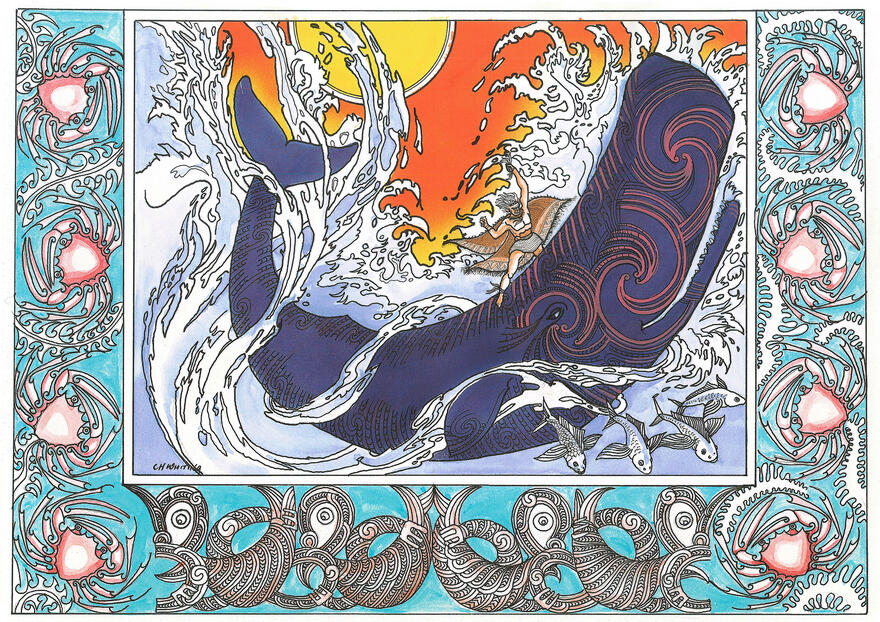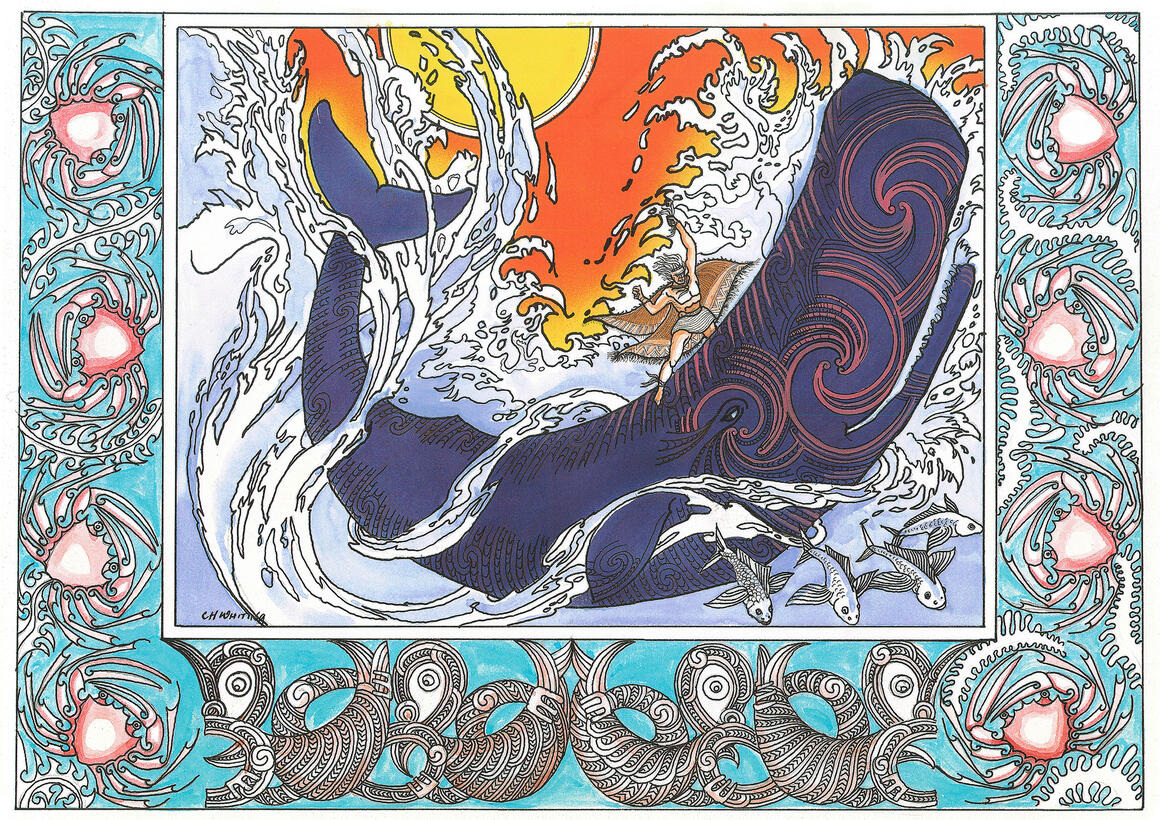When Paikea migrated from Rangiātea in the Pacific, he came eventually to the east coast of the North Island. At Whangarā he found places in the new land which reminded him of places at the original Whangarā where he had come from. He conferred on these places in the new land names which he had brought with him from his homeland.


When Paikea migrated to New Zealand from Rangiātea, he brought with him many place names and transferred them to places on the east coast of the North Island, to serve as reminders of the homeland he had left behind.
On a visit to Rarotonga in 1989, Hēni Sunderland of Gisborne, herself a descendant of Paikea, visited the island of Mauke, an earlier name for which is Ahuahu, in search of her Paikea roots. She learned from the elders of Mauke that legends about Paikea were well known on that island. During a hurricane on Mauke, when many people perished, Paikea survived by clinging to some debris on which he was carried across to the island of Mangaia. His wife watched as he was washed away clinging to the debris. She waited and watched for his return from that cliff top until she died. She was buried there and her grave is marked and revered to this day.
Paikea's survival of the hurricane was seen as a miracle. The event led to his name being changed from Kahutia Te Rangi to Paikea. Paikea is the name of a species of crab, well known as the only crab able to survive hurricanes by the tenacity with which it clings to debris, no matter how strong the wind. Paikea lived on Mangaia for some time before leaving, never to be heard of on those islands again. Some of his descendants still live on Mangaia.
Paikea then appears in Aotearoa on the back of a whale. He left Rarotonga on a type of canoe called tohorā, one specially carved in the shape of a whale, hence its name tohorā, the word for whale. This is likely to be the origin of the legend that Paikea arrived in Aotearoa on the back of a whale.
The Ngāti Porou version of the time and place of Paikea's arrival is that "Paikea landed on these shores during the time kūmara seedlings were ready for planting, the time when the mounds were being prepared to receive the kūmara plants, the time when the wind was blowing the perehia seeds into the sea". (White, Ancient History of the Māori, vol. 3, p. 35)
Paikea made landfall at Ahuahu, Great Mercury Island, so called because he heaped up sand around him to keep warm, 'ahuahu' meaning to heap up. But this was also, as Hēni Sunderland learned on Mauke, an old name for Paikea's home island. There were people already living on Ahuahu, one of whom Paikea married. Her name was Ahumoa I Raka. More than one canoe of the migrations made first landfall at Ahuahu, Takitimu and Tainui to name only two. Ahuahu was still used during the early part of this century by the Ngāti Hei of Whitianga and Tairua as a place for mahinga kai (food planting and gathering, mainly, in this case, kūmara growing). Ngāwhira Tainui, who died in the 1960s, the last of her generation of the chiefly line of Tainui of Ngāti Hei, referred to Ahuahu as Hawaiki, because kūmara grew well there all year round. The tūpuna of her generation also maintained that the name Ahuahu was brought from the islands, which supports Hēni Sunderland's discovery that Mauke's original name was Ahuahu.
From Ahuahu, Paikea moved to Whakatāne, where he took a second wife before travelling further east, following the coast to Waipahu. There he married Huturangi, the daughter of the chief Whironui. He continued his migration southwards along the coast with his wife Huturangi and her people. Paikea built a pa for his father-in-law Whironui and his people near Roto a Tahe. Some of the people stayed there but some followed Paikea further south.
Paikea's party eventually reached Koutū a Moa and Torouka and looked back towards Whangarā, in full Whangarā Mai Tawhiti (Whangarā from afar). Paikea pointed out certain places at which they were looking and said "They remind me of places at home". He pointed to some of the places, saying: "That is like Pākārae, that is like Waingutu, and that like Toka Kuku, and that like Rangitoto, that place is like Te Uhia I Rākau, that place looks like Pukehāpopo, and that like Waipaepae, and that like Whakakino, and that like Ahi Rārāriki, and that like Ahi Rārāihe, that place is like Tū Tapuninihi, and that like Taha Tū O Te Rangi, and that is like Te Waruhanga A Hine, and those are like Pukehore and Te Rerenga.
The names I have given are names of places at my old home. In fact this is exactly like the Whangarā from whence I came. There is only one difference and that is the place I now call Waimoko is at the back of what I now call Pukehāpopo. If Waimoko here had been near the place I now call Ahi Rārāriki, it would have been exactly like my old home in Hawaiki. Therefore I shall name this place Te Whangarā Mai Tawhiti."
Te Ana Ō Paikea is an island which lies at the southern end of the bay of Whangarā. At first glance, it looks like a large stranded whale. It is sacred because of its association with Paikea. He built his first home on its highest peak and called it Whitirēia after his former home in Hawaiki.
The present meeting house in Whangarā bears this historic name.
Many ancestors whose names are borne by present-day tribes were descended from this great rangatira, Paikea. Eight generations down from Paikea were born two brothers, Porourangi and Tahupōtiki. Porourangi is the eponymous ancestor of the Ngāti Porou confederation of tribes; Tahupōtiki, who went to Te Waipounamu, is the eponymous ancestor of the Kāi Tahu tribe of the South Island. Kahungunu, descended from Porourangi, founded Ngāti Kahungunu, whose territory is between Wairoa and Wairarapa. Mahinarangi, who descended in turn from Kahungunu, married Tūrongo and is the ancestor of the present Ariki Tapairu Te Ata I Rangikahu of the Tainui confederation of tribes.
When Paikea died, his remains were placed in a cave on the island on which he lived, hence its name Te Ana ō Paikea, the cave of Paikea.
Place Names from Paikea's Journey
Place names associated with Paikea's arrival
- Ahuahu
- Heaping up (of sand); also the island of Mauke in the Cook Islands
- Whangarā Mai Tawhiti
- Whangarā from afar
- Te Ana ō Paikea
- The cave of Paikea
-
Place names which Paikea transferred from the original
- Ahuahu
- Pākārae
- Pukehāpopo
- Tū Tapuninihi
- Waimoko
- Waingutu
- Waipaepae
- Taha Tū o Te Rangi
- Whitirēia
- Toka Kuku
- Whakakino
- Te Waruhanga a Hine
- Rangitoto
- Ahi Rārāriki
- Pukehore
- Te Uhia i Rākau
- Ahi Rārāihe
- Te Rerenga
Reproduced courtesy of the New Zealand Geographic Board copyright.